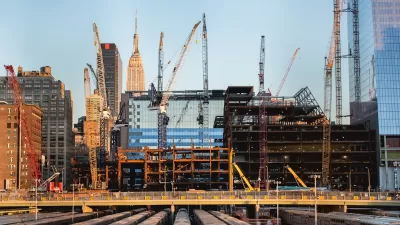Almost all the affordable housing development in L.A. in the past decade has occurred in majority-minority neighborhoods. The L.A. Department of City Planning is looking for ways to make sure high-income areas do more of their fair share.

The Los Angeles Department of City Planning (DCP) is hoping to leverage the eight-year Regional Housing Allocation (RHNA) process to ensure that affordable housing development and growth are distributed equitably across its neighborhoods.
According to an article by Steven Sharp, DCP staff co-authored a new report with the city's Housing and Community Investment Department to document the inequities of affordable housing development in L.A. over the past decade. The report also suggests short- and long-term policies designed to shift the distribution of affordable housing to more affluent parts of the city.
According to Sharp's summary of the report's finding, "over the past decade, affordable housing has been increasingly concentrated in majority-minority neighborhoods in Central and South Los Angeles, which have long been characterized by poverty and segregation." Specifically, "Just 14 percent of the city's affordable units over that time period - nearly 1,600 in total - were built in high-resource communities, compared to 62 percent in low-resource neighborhoods."
The report also blames zoning for contributing to that divide. "In high resource communities, 76 percent of residential parcels are zoned for single-family uses, with 20 percent set aside for apartments," explains Sharp. " In low resource neighborhoods, the ratio is flipped, with 80 percent of residential land zoned for apartments and just 20 reserved for single-family homes."
The policy recommendations in the report include zoning changes that target high-opportunity communities proximate to transit routes. "Additionally, the report proposes more flexible zoning and new incentives to promote the construction of so-called 'missing middle' housing in current single-family and low-density neighborhoods," reports Sharp. Also included in the report's policy recommendations: the idea of a citywide inclusionary zoning policy.
More details and recommendations are included in the source article linked below.
FULL STORY: Planning Department proposes "fair share" allocations for affordable housing

Study: Maui’s Plan to Convert Vacation Rentals to Long-Term Housing Could Cause Nearly $1 Billion Economic Loss
The plan would reduce visitor accommodation by 25,% resulting in 1,900 jobs lost.

North Texas Transit Leaders Tout Benefits of TOD for Growing Region
At a summit focused on transit-oriented development, policymakers discussed how North Texas’ expanded light rail system can serve as a tool for economic growth.

Why Should We Subsidize Public Transportation?
Many public transit agencies face financial stress due to rising costs, declining fare revenue, and declining subsidies. Transit advocates must provide a strong business case for increasing public transit funding.

How to Make US Trains Faster
Changes to boarding platforms and a switch to electric trains could improve U.S. passenger rail service without the added cost of high-speed rail.

Columbia’s Revitalized ‘Loop’ Is a Hub for Local Entrepreneurs
A focus on small businesses is helping a commercial corridor in Columbia, Missouri thrive.

Invasive Insect Threatens Minnesota’s Ash Forests
The Emerald Ash Borer is a rapidly spreading invasive pest threatening Minnesota’s ash trees, and homeowners are encouraged to plant diverse replacement species, avoid moving ash firewood, and monitor for signs of infestation.
Urban Design for Planners 1: Software Tools
This six-course series explores essential urban design concepts using open source software and equips planners with the tools they need to participate fully in the urban design process.
Planning for Universal Design
Learn the tools for implementing Universal Design in planning regulations.
City of Santa Clarita
Ascent Environmental
Institute for Housing and Urban Development Studies (IHS)
City of Grandview
Harvard GSD Executive Education
Toledo-Lucas County Plan Commissions
Salt Lake City
NYU Wagner Graduate School of Public Service





























